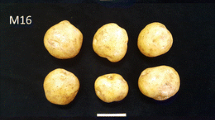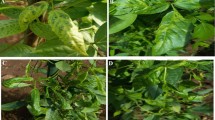Summary
Accessions from exotic Solanum species, including diploid and tetraploid species, were screened for immunity to Clavibacter michiganensis subsp. sepedonicus, the causal agent of potato ring rot. The diploid species included S. infundibuliforme, S. lesteri, S. megistacrolobum, S. tuberosum Group Phureja, S. polyadenium, S. pinnatisectum, S. raphanifolium, S. sparsipilum, S. sanctae-rosae, S. tuberosum Group Stenotomum, S. toralapanum, and S. verrucosum. The tetraploid species included S. tuberosum Group Andigena, S. acaule, S. fendleri, S. hjertingii, S. oplocense, S. polytrichon, and S. stoloniferum. Apparent immunity was initially found in several diploid species, but was not present during subsequent retesting. Immunity was found in nine accessions of tetraploid S. acaule. These accessions maintained their immunity during testing over an eight-month period. S. acaule appears to be a good source of immunity for introgression studies.
Similar content being viewed by others
References
Baer, D. & N.C.Gudmestad, 1991. Serological detection of nonmucoid strains of Clavibacter michiganensis subsp. sepedonicus in potato. Phytopathology 82: 157–163.
Bishop, A.L. & S.A.Slack, 1981. Population levels of Corynebacterium sepedonicum and symptom development of ring rot in potato plants. Phytopathology 71: 861.
Bishop, A.L. & S.A.Slack, 1987. Effect of inoculum dose and preparation, strain variation, and plant growth conditions in the eggplant assay for bacterial ring rot. Am. Potato J. 64: 227–234.
Bonde, R., F.J.Stevenson, C.F.Clark & R.V.Akeley, 1942. Resistance of certain potato varieties and seedling progenies to ring rot. Phytopathology 32: 813–819.
DeBoer, S.H. & A.Wieczorek, 1984. Production of monoclonal antibodies to Corynebacterium sepedonicum. Phytopathology 74: 1431–1434.
DeBoer, S.H. & M.E.McNaughton, 1986. Evaluation of immunofluorescence with monoclonal antibodies for detecting latent bacterial ring rot infections. Am. Potato J. 63: 533–543.
DeBoer, S.H. & M.McCann, 1990. Detection of Corynebacterium sepedonicum in potato cultivars with different propensities to express ring rot symptoms. Am. Potato J. 67: 685–694.
Gudmestad, N.C., D.Baer & C.J.Kurowski, 1991. Validating immunoassay test performance in the detection of Corynebacterium sepedonicum during the growing season. Phytopathology 81: 475–480.
Gutbrod, O., 1987. Certification policies and practices in reference to bacterial ring rot. Am. Potato J. 64: 677–681
Hanneman, R.E. Jr. & J.B. Bamberg, 1986. Inventory of tuberbearing species. Wis. Agric. Exp. Sta. Bull. 533. Madison.
Johnston, S.A., T.P.M.denNijs, S.J.Peloquin & R.E.HannemanJr., 1980. The significance of genic balance to endosperm development in interspecific crosses. Theor. Appl. Genet. 57: 5–9.
Kurowski, C.J. & F.E.Manzer, 1992. Reevaluation of Solanum species accessions showing resistance to bacterial ring rot. Am. Potato J. 69: 289–297.
Logsdon, C.E., 1967. Effect of soil temperature on potato ring rot. Am. Potato J. 25: 281–286.
Manzer, F.E. & A.R.McKenzie, 1988. Cultivar response to bacterial ring rot infection in Maine. Am. Potato J. 65: 333–339.
Matthews, R.E.F., 1991. Plant Virology. Academic Press, Inc. New York.
Miller, H.J., 1984. A method for the detection of latent ringrot in potatoes by immunofluorescence microscopy. Potato Res. 27: 33–42.
Nelson, G.A., 1982. Corynebacterium sepedonicum in potato: effect of inoculum concentration on ring rot symptoms and latent infection. Can. J. Plant Pathol. 4: 129–133.
Nelson, G.A. & R.R.Harper, 1973. Factors affecting ring rot development in root-inoculated potato plants originating from stem cuttings. Am. Potato J. 50: 365–370.
Nelson, G.A. & G.C.Kozub, 1983. Effect of total light energy on symptoms and growth of ring rot-infected Red Pontiac potato plants. Am. Potato J. 60: 461–468.
Nelson, G.A. & B.C.Kozub, 1987. Effect of temperature and latent viruses on atypical ring rot symptoms of Russet Burbank Potatoes. Am. Potato J. 64: 589–597.
Nelson, G.A., W.E.Torfason & F.R.Harper, 1971. Comparison of inoculation methods in ring rot development in potato. Am. Potato J. 48: 225–229.
Racicot, H.N., D.B.O.Savile & I.L.Conners, 1938. Bacterial wilt and rot of potatoes-some suggestions for its detection, verification, and control. Am. Potato J. 15: 312–318.
Schaad, M.W. (ed.), 1980. Lab Guide for Identification of Plant Pathogenic Bacteria. Ann. Phytopathol. Soc., St. Paul, Minn.
Sherf, A.F., 1949. Root inoculation, a method insuring uniform rapid symptom development of bacterial ring rot of potato. Phytopathology 39: 507–508.
Spicer, P.B., 1961. Use of gibberellin to hasten germination of Solanum seed. Nature 189: 327–328.
Sun, M.K.C. & G.D.Easton, 1983. Symptom expression of Corynebacterium sepedonicum-infected Russet Burbank potato plants in Montana. Am. Potato J. 60: 822.
Author information
Authors and Affiliations
Rights and permissions
About this article
Cite this article
Kriel, C.J., Jansky, S.H., Gudmestad, N.C. et al. Immunity to Clavibacter michiganensis subsp. sepedonicus: Screening of exotic Solanum species. Euphytica 82, 125–132 (1995). https://doi.org/10.1007/BF00027058
Received:
Accepted:
Issue Date:
DOI: https://doi.org/10.1007/BF00027058




